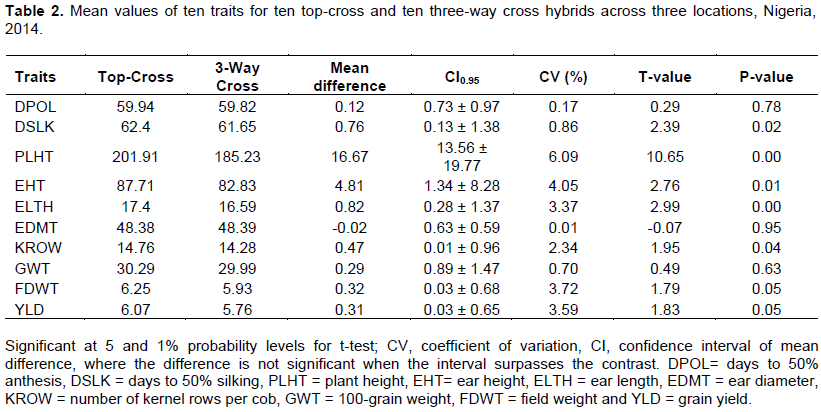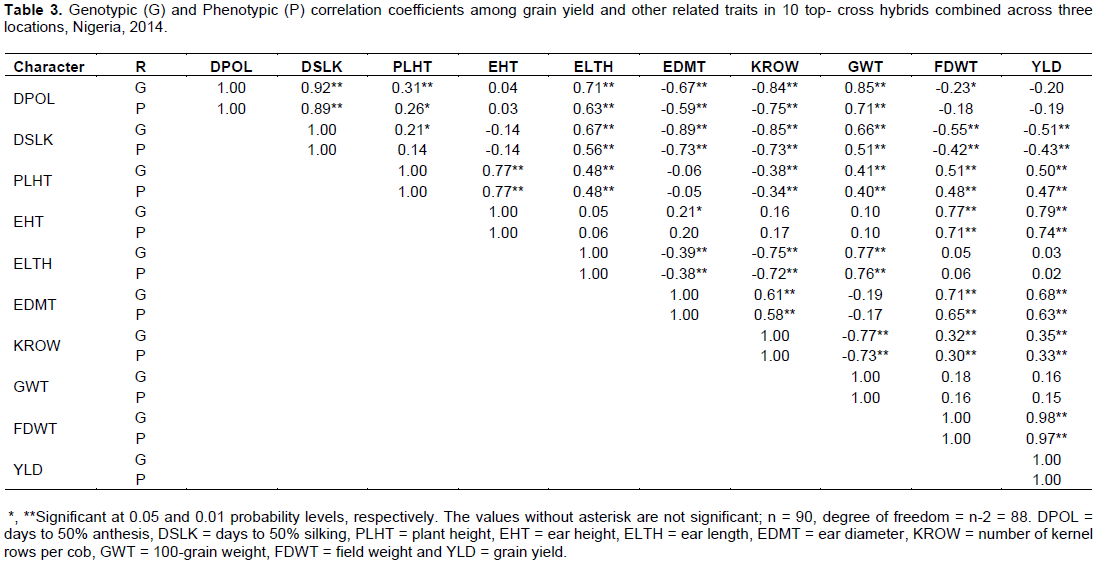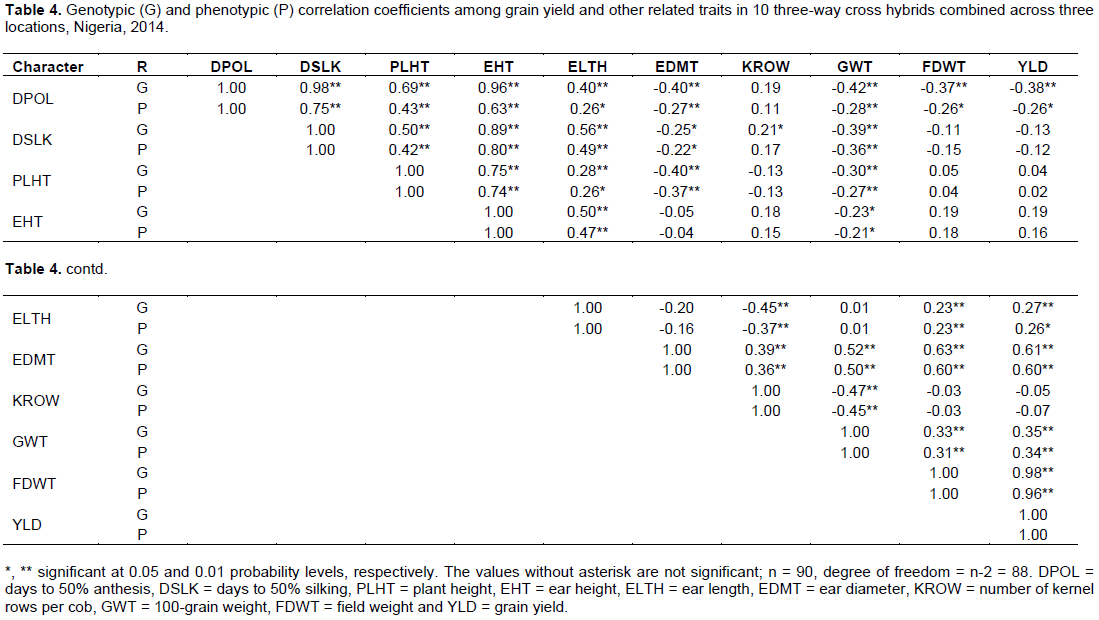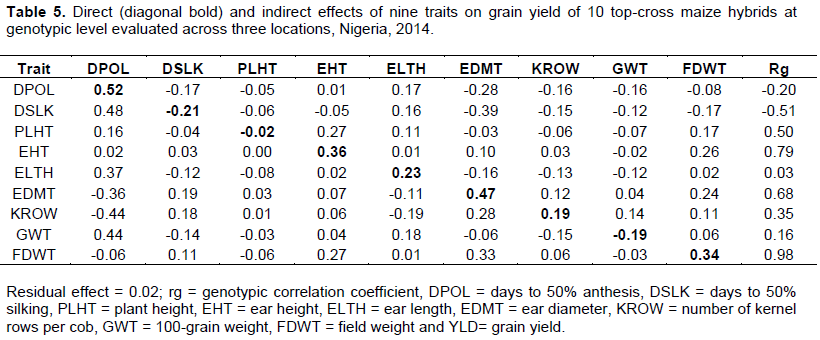ABSTRACT
Grain yield is a complex quantitative trait that depends on a number of other traits for selection. This study was carried out to reveal the pattern of association with and contribution of traits to grain yield in two maize populations evaluated in three agro-ecological zones of South-Western Nigeria during the 2014 cropping season. The experiment consisted of 10 top-cross and 10 three-way cross maize hybrids, laid out in a randomised complete block design with three replications. Genotypic and phenotypic correlation coefficients and path co-efficient analyses were performed for each hybrid population across the three locations. Results showed significant (p≤0.05) differences between the two hybrid populations for all the traits mentioned except days to 50% anthesis, ear diameter and 100-grain weight. Field weight in both hybrid populations, number of kernel rows per cob, ear diameter and ear height in top-cross hybrids, as well as ear length and 100-grain weight in the three-way cross hybrids were directly correlated with grain yield. The link between direct and indirect effects on grain yield depends on hybrid population, although some traits showed similar direct effects in both hybrid populations. These traits can be used as the main criteria for grain yield improvement in the respective hybrid populations.
Key words: Correlation, path coefficient analysis, hybrid populations, maize (Zea mays L.), grain yield.
Maize (Zea mays L.) is one of the most superior cereal crops in the world due to its wide adaptation and varieties of utilisation. It is the most important cereal in Sub-Saharan Africa that is mainly used for food and feed with a small percentage used in agro-allied industries (IITA, 2009). The spread of maize cultivation in the world was
due to its diversity, high adaptability and versatility (Obi, 1991). In Nigeria, maize is rapidly replacing in other cereals (sorghum and millet) in the Savannahs (Fakorede et al., 2003). This might be attributed to its high yields per unit area, husk protection against birds and ability to compete with weeds (Onwueme and Singha, 1991). Despite an increased area of land used for cultivation of maize since the mid- 2000s, production per hectare is still low (1.3 ton/hectare) compared to the 8.6 t/ha in developed countries (IITA, 2007). However, maize yield in Nigeria increased by 57% between 1994 and 2013 with average yield of 1.9 ton/hectare in 2012 and 2013 (FAOSTAT, 2015). This increase might be attributed to better inputs (fertilizer, agrochemicals, irrigations and improved seeds) especially the use of improved varieties.
Hybrid maize are known to be high yielding, superior and vigorous because of hybrid vigour (heterosis) arising from crossing two genetically unrelated parents. There are different types of hybrid this include; single cross, three way cross, double top cross and top cross. A top-cross is a cross between an inbred line and an open pollinated variety while a three-way hybrid is across between an inbred line and single cross hybrid. Top-cross hybrids are considered to be the quickest means of developing hybrids and produce good quantity of seeds compared to a single cross hybrid. The cost of producing top-cross hybrids is comparatively cheaper than conventional hybrid seeds (Bidinge et al., 2005). The decline in grain yield due to recycling top cross hybrid seed is half of that of classical hybrids (Pixley and Banziger, 2004). Given that many farmers recycle seeds set aside from their harvest, the use of non-conventional top cross hybrids could be one approach of enhancing yield levels in maize. Three-way cross hybrids are also regularly used since they are cheap in seed production. They are intermediate between single and double cross hybrids with respect to uniformity, yield, stability and the relative simplicity of selecting and testing (Weatherspoon, 1970).
Grain yield is a complex quantitative trait that depends on a number of other agronomic traits for selection (Fellahi et al., 2013). In order to achieve effective selection for grain yield, it is important to determine its relationship with other traits. The determination of correlation coefficients helps to measure the level of relationships among traits and to establish the level at which these traits are mutually different (Bocanski et al., 2009; Nagabhushan et al., 2011). Correlation coefficients give reliable and useful information on the relationship between the traits in terms of the nature, extent and direction of selection (Zeeshan et al., 2013). Path-coefficient analysis helps to know the nature, extent and direction of selection; it is the most valuable tool commonly used to establish the exact relationships in terms of cause and effect, identify the direct, indirect and total (direct plus indirect) causal effects, as well as to remove any spurious effect that may be present (Hefny, 2011). However, although several studies on relationships between grain yield and its component traits have been conducted in maize (Mohammadi et al., 2003; Saidaiah et al., 2008; Bello et al., 2010; Kumar et al., 2011; Pavan et al., 2011), most did not consider the simultaneous behaviour of such traits between different classes of hybrids. Teodoro et al. (2014) studied the primary and secondary components that are directly or indirectly related to grain maize grain yield. They found out that the link between direct and indirect effects on productivity depends on genetic class. It is therefore important to examine the simultaneous character association and contribution of each of the traits in top-cross and three-way cross hybrids in order to give more attention to those having the greatest influence on grain yield.
The 20 hybrids comprising 10 top-cross and 10 three-way cross hybrid varieties, used for this study (Table 1) were collected from the Genetic Resources Centre (GRC) of the International Institute of Tropical Agriculture (IITA), Ibadan, Nigeria.
Field experiments were conducted during the 2014 cropping season at three diverse environments of South-Western Nigeria: The Teaching and Research Farm of the Federal University of Agriculture, Abeokuta, Ogun State [7° 14' North , 3° 26' East and 162 m above sea level (masl)]; National Institute of Horticultural Research, Ibadan, Oyo State (7° 24' N, 3° 50' E and 184 masl); and Federal University of Technology, Akure, Ondo State (7° 18' N, 5° 07' E and 380 masl). The mean monthly rainfall and temperature for each location during the experiment (June - November) are presented in Figures 1 to 3.


At each location, the soil was mechanically ploughed and harrowed. The trials were laid out in randomised complete block design with three replications. Each variety was planted in two-row plots 5 m long, at a spacing of 75 cm × 50 cm. Three seeds per hole were planted and later thinned to two plants per hole. A compound fertilizer of NPK 15:15:15 was applied at the rates of 60 kgN, 60 kgP and 60 kg K2O ha-1 at two weeks after planting. An additional 60 kgN ha-1 was also applied as side dressing six weeks after planting (WAP) using urea (46%N). Other crop management practices were applied following the standard recommendations at each location. Sowing of seeds was done on 7th, 9th and 21st August, 2014 at Ibadan, Akure and Abeokuta, respectively.
For each entry, data were collected on plant height (cm), ear height (cm), ear length (cm), ear diameter (mm), 100-grain weight (g) and number of kernel rows per cob on 10 randomly selected plants, while the number of days to 50% anthesis (days), days to 50% silking (days), field weight (kg) and grain yield (t/ha) were determined on a plot basis.
Statistical analysis
Data for each hybrid population, averaged over the three locations, were grouped for each trait and compared by t-test at 5 and 1% probability levels. Data were also subjected to analysis of variance and covariance for each hybrid population across locations using the SAS software version 9.1 (SAS Institute, 2000). The generated components of the variance and covariance were used to estimate the genotypic and phenotypic correlation coefficients as suggested by Singh and Chaudhary (1985):
Where: X1 and X2 = characters X; Covg = genotypic covariance and Covp= phenotypic covariance; Varg = genotypic variance and Varp= phenotypic variance.
Test of significance (at 5 and 1% probability levels) of correlation was done by comparing the computed values against table ‘r’ values given by Fisher and Yates (1963) at n-2 degree of freedom, where, n = number of genotypes x number of locations x number of replications.
The correlation coefficients of all the traits were partitioned into direct and indirect effects by path coefficient analysis using the R statistical package version 3.0.3 (R Core Team, 2014) following the procedure of Dewey and Lu (1959). The path coefficient simultaneous equations of Ahmed et al. (2002) were adopted.
The residual effect was obtained as Px = 1 - Pxy rxy. Where, Px = residual effect of variable X;
Pxyrxy= product of direct effect of variance X and its correlation (r) with yield (Y).
Table 2 presents the mean values of traits for ten top-cross and ten three-way cross hybrids across the three locations. The results showed significant (p≤0.05) differences between the top-cross and three-way cross hybrids for days to 50% silking, plant height, ear height, ear length, number of kernel rows per cob, field weight and grain yield. However, there were no significant differences observed between the two hybrid populations for days to 50% anthesis, ear diameter and 100-grain weight.

Estimation of genotypic and phenotypic correlation coefficients of grain yield and other yield-related traits are presented for top-cross hybrids (Table 3) and three-way hybrids (Table 4). Table 3 shows a positive and highly significant genotypic and phenotypic correlation (p˂0.01) between grain yield with plant height (rg = 0.50 for genotypic correlation and rp = 0.47 for phenotypic correlation), ear height (0.79 and 0.74), ear diameter (0.68 and 0.63), number of kernel rows per cob (0.35 and 0.33) and field weight (0.98 and 0.97). On the other hand, a negative and significant correlation with days to 50% silking (-0.51 and -0.43 p˂0.01). There was a positive and highly significant genotypic and phenotypic correlation between 100-grain weight, days to 50% anthesis, days to 50% silking, plant height and ear length. Table 4 shows that grain yield had a positive and highly significant genotypic and phenotypic correlation with ear length [rg= 0.27 (p˂0.01) and rp= 0.26 (p˂0.05)], ear diameter [0.61 and 0.60 (p˂0.01)], 100-grain weight [0.35 and 0.34 (p˂0.01)] and field weight [0.98 and 0.96 (p˂0.01)]. However, we noticed a negative and significant correlation with days to 50% anthesis [-0.38 and -0.26 (p˂0.01)]. The genotypic and phenotypic correlation of 100-grain weight with ear diameter and field weight was positive and highly significant


Table 5 presents the genotypic direct and indirect effects of nine traits on grain yield for the top-cross hybrids. There was maximum positive direct effect on grain yield by days to 50% anthesis (0.52), ear diameter (0.47), ear height (0.36), field weight (0.34), ear length (0.23) and number of kernel rows per cob (0.19). However, days to 50% silking (-0.21), 100-grain weight (-0.19) and plant height (-0.02) exerted negative direct effects on grain yield. The genotypic direct and indirect effects of nine traits on grain yield for the three-way cross hybrids are presented in Table 6. The highest positive direct effect on grain yield was recorded for field weight (0.99) and number of kernel rows per cob (0.99) followed by 100-grain weight (0.98), plant height (0.59), ear length (0.49) and days to 50% silking (0.41). On the other hand, ear height (-0.93), ear diameter (-0.89) and days to 50% anthesis (-0.21) had negative direct effects on grain yield. Traits in three-way cross hybrids contributed higher values on grain yield than those in top-cross hybrids.


Significant and positive correlation between two traits suggests that these traits can be improved simultaneously in a selection programme, because of mutual relationships that exist among traits (Hayes et al., 1955). This study revealed that both genotypic and phenotypic correlation coefficients were significant in most of the character association and the magnitude of genotypic correlation coefficients for most of the characters was higher than their corresponding phenotypic correlation coefficients, except in a few cases, in both hybrid populations. This indicates the low influence of the environment in the total expression of the hybrids. This also indicates an inherent relationship between the traits studied. Such results are in line with the findings of Hefny (2011), Zeeshan et al. (2013) and Nataraj et al. (2014). The observed positive and significant genotypic and phenotypic correlations of grain yield with plant height, ear height, ear diameter, number of kernel rows per cob and field weight in top-cross hybrids, ear length, ear diameter, 100-grain weight and field weight in three-way cross hybrids indicate that these traits are essential yield components, reflective estimators and selection for them in the respective hybrid populations may lead to a substantial improved grain yield. Nataraj et al. (2014) reported similar observations in both hybrid classes. Furthermore, in top-cross hybrids, ear height, ear diameter, field weight and grain yield had positive and significant genotypic correlation with each other. This means that an increase in one trait would ultimately increase another and thereby increase grain yield. The negative significant genotypic and phenotypic correlations between grain yield and days to 50% silking in top-cross hybrids and days to 50% anthesis in three-way cross hybrids will enhance the development of early maturing and high-yielding varieties in the respective hybrid populations. Similar results confirming these results have been reported by Nataraj et al. (2014). Hefny (2011) reported negative non-significant genotypic and phenotypic correlation between yield plant-1, days to 50% anthesis and days to 50% silking under optimal sowing conditions. However, in both hybrid populations, the genotypic and phenotypic correlations between grain yield, ear diameter and field weight were positive and significant, suggesting the reliability of these traits as good selection indices for high grain yield in both hybrid populations. Contrary to this result, Teodoro et al. (2014) reported a positive correlation between yield, weight of 100-grains and number of kernels per row in both genetic classes of single and triple-cross maize hybrids. The present study further confirms the notion that the association of characters with yield in maize depends on the genetic class. Also, the significant positive correlations between 100-grain weight, days to 50% anthesis, days to 50% silking, plant height, and ear length further confirm the finding by Ojo et al. (2006) that 100-grain weight is a good index for selection.
With the magnitude of the contribution by each trait to grain yield, each hybrid population can be improved using the path information. Field weight, ear length and kernel rows per cob had positive direct effects on grain yield in both hybrid populations. In addition, days to 50% anthesis, ear diameter and ear height exhibited positive direct effects on grain yield in top-cross hybrids, whereas days to 50% silking, plant height and 100-grain weight had positive direct effects on grain yield in the three-way cross hybrids. This indicates that a slight increase in any of the above traits in the respective hybrid populations may directly contribute to an increase in grain yield. Similar results were reported by various researchers. For instance, Teodoro et al. (2014) reported a high direct effect of number of grains row-1 and weight of 100-grains on grain yield in both genetic classes. Similarly, Hefny (2011) observed a direct positive effect of ear weight plant-1, days to 50% anthesis, 100-grain weight and ear length (at early sowing); and ear diameter, days to 50% silking and days to 50% anthesis (at late sowing) on yield. The negative direct effects observed in this study by days to 50% silking, 100-grain weight and plant height in top-cross hybrids, and ear height, ear diameter and days to 50% anthesis in three-way cross hybrids indicate that these traits only contribute to grain yield mainly through their high and positive indirect effects on other characters in the respective hybrid populations. Days to 50% silking and 100-grain weight showed the highest positive indirect effect on grain yield through days to 50% anthesis, while plant height had the highest positive indirect effect on grain yield via ear height in the top-cross hybrids. In the three-way cross hybrids, maximum positive indirect effect on grain yield was exhibited by days to 50% anthesis and ear height via days to 50% silking and plant height (and field weight in addition to ear height), whereas ear diameter showed the highest positive indirect effect on grain yield through field weight and 100-grain weight. Rigon et al. (2014) reported a direct negative effect of number of grains per ear and weight of 100 grains in maize. They found that these traits had the highest positive indirect effect on yield through mass per ear.
From the study, field weight in both hybrid populations, number of kernel rows per cob, ear diameter and ear height in the top-cross hybrids, as well as ear length and 100-grain weight in the three-way cross hybrids were directly correlated with grain yield. These traits can be used as the main criteria for grain yield improvement in the respective hybrid populations. Some traits showed similar direct effects in both hybrid populations, but the link between direct and indirect effects on grain yield depends on hybrid population.
The authors have not declared any conflict of interests.
REFERENCES
|
Ahmed ST, Asiribo OE, Ahmed MK (2002). Path Analysis of Factors Affecting Vesico Vaginal Fistula in Nigeria. Nokoei, S. (ed) Biometry and Quality of Life. Proceeding of meeting SAUSAN_IBS 23-27 August, 1999, Ibadan, Nigeria, pp. 114-119.
|
|
|
|
International Institute of Tropical Agriculture (2007). Maize.
|
|
|
|
International Institute of Tropical Agriculture (2009). Crops [Internet]. Nigeria: International Institute of Tropical Agriculture.
View
|
|
|
|
Bello OB, Abdulmaliq SY, Afolabi MS, Ige SA (2010). Correlation and path coefficient analysis of yield and agronomic characters among open pollinated maize varieties and their F1 hybrids in a diallel cross. Afr. J. Biotechnol. 9:2633-2639.
|
|
|
|
Bidinge FR, Raj AGB, Negusse A, Adam MA, Obilana AB, Jones RB (2005). Top Cross Hybrids as an Entry into Commercial Seed Production of Pearl Millet in Eastern Africa. Exper. Agric. 41:335-356.
Crossref
|
|
|
|
Bocanski J, Sreckov Z, Nastasic A (2009). Genetic and Phenotypic Relationship between Grain Yield and Components of Grain Yield of Maize (Zea mays L.). Genetika 41(2):145-154.
Crossref
|
|
|
|
Dewey DR, Lu KH (1959). A Correlation and Path-coefficient Analysis of Components of Crested Wheat Grass Seed Production. Agron. J. 51:515-518.
Crossref
|
|
|
|
Fakorede MAB, Badu-Apraku B, Kamara AY, Menkir A, Ajala SO (2003). Maize Revolution in West and Central Africa. In Proceedings of a Regional Maize Workshop, May 14–18, 2001, edited by B. Badu-Apraku, M.A.B Fakorede, M. Ouedraogo, R.J. Carsky, and A. Menkir. Cotonou. Ibadan: WECAMAN IITA. pp. 3-5.
|
|
|
|
FAOSTAT (2015). Food and Agricultural Organisation of the United Nation. FAOSTAT Database
View
|
|
|
|
Fellahi Z, Hannachi A, Bouzerzour H, Boutekrabt A (2013). Correlation between Traits and Path Analysis Coefficient for Grain Yield and Other Quantitative Traits in Bread Wheat under Semi-Arid Conditions. J. Agric. Sustain. 3(1):16-26.
|
|
|
|
Fisher RA, Yates F (1963). Statistical Tables for Biological, Agricultural and Medical Research. 6th ed. Hafner Press, New York, USA. p. 63.
|
|
|
|
Hayes HK, Immer FR, Smith DC (1955). Methods of Plant Breeding, 2nd ed.; McGraw-Hill Book Co.: New York, NY, USA. P 551.
|
|
|
|
Hefny M (2011). Genetic Parameters and Path Analysis of Yield and its Components in Corn Inbred Lines (Zea may L.) at Different Sowing Dates. Asian J. Crop Sci. 3(3):106-117.
Crossref
|
|
|
|
Kumar TS, Reddy DM, Reddy KH, Sudhakar P (2011). Targeting of traits through assessment of interrelationship and path analysis between yield and yield components for grain yield improvement in single cross hybrids of maize (Zea mays L.). Int. J. Applied Biol. Pharma. Technol. 2:123-129.
|
|
|
|
Mohammadi SA, Prasanna BM, Singh NN (2003). Sequential path model for determining interrelationships among grain yield and related characters in maize. Crop Sci. 43:1690-1697.
Crossref
|
|
|
|
Nagabhushan NM, Mallikarjuna CH, Shashibhaskar MS, Prahalada GD (2011). Genetic Variability and Correlation Studies for Yield and Related Characters in Single Cross Hybrids of Maize (Zea mays L.). Current Biot. 5:157-163.
|
|
|
|
Nataraj V, Shahi JP, Agarwal V (2014). Correlation and Path Analysis in Certain Inbred Genotypes of Maize (Zea mays L.) at Varanasi. Intl. J. Innov. Res. Dev. 3(1):14-17.
|
|
|
|
Obi IU (1991). Maize: Its agronomy, diseases, pests and food values optimal computer solutions limited, Enugu 208p.
|
|
|
|
Ojo DK, Omikunle OA, Oduwaye OA, Ajala MO, Ogunbayo SA (2006). Heritability, Character Correlation and Path Coefficient Analysis among Six Inbred-Lines of Maize (Zea mays L.). World J. Agric. Sci. 2(3):352-358.
|
|
|
|
Onwueme IC, Sinha TD (1991). Field Crop Production in Tropical Africa. CTA, Ede, the Netherlands 480p.
|
|
|
|
Pavan R, Lohithaswa MC, Walli MC, Gangashetty P, Shekara BG (2011). Correlation and path coefficient analysis of grain yield and yield contributing traits in single cross hybrids of maize (Zea mays L.). Electron. J. Plant Breed. 2:253-257.
|
|
|
|
Pixley R, Bazinger M (2004). Open-pollinated Maize Varieties: A Backward Step or Valuable Options for Farmers? In: Frisen, D.R. and A.F.E. Palmer (editorial). Integrated approaches to higher maize productivity in the new millennium. Proceeding, of the seventh Eastern and Southern Africa Regional Maize Conference. 5-11 February 2002. Nairobi, Kenya. CIMMYT and Kari. pp. 22-28.
|
|
|
|
R Core Team (2014). R: A Language and Environment for Statistical Computing. R Foundation for Statistical Computing, Vienna, Austria.
View
|
|
|
|
Rigon JPG, Rigon CAG, Capuani S (2014). Quantitative Descriptors and Their Direct and Indirect Effects on Corn Yield. Biosci. J. Uberlandia 30:356-362.
|
|
|
|
Saidaiah P, Satyanarayana E, Kumar SS (2008). Association and path coefficient analysis in maize (Zea mays L.). Agric. Sci. Digest. 28:79-83.
|
|
|
|
SAS Institute (2000). Statistical Analysis Software (SAS) User's Guide Version 9.1. SAS Institute, Inc., Cary, NC, USA.
|
|
|
|
Singh RK, Chaudhury BD (1985). Biometrical Methods in Quantitative Genetic Analysis. Kalayani Publishers, New Delhi, India. P 318.
|
|
|
|
Teodoro PE, da Silver Junior CA, Correa CC, Ribeiro LP, de Oliveira EP, Lima MF, Torres FE (2014). Path Analysis and Correlation of Two Genetic Classes of Maize (Zea mays L.). J. Agron. 13(1):23-28.
Crossref
|
|
|
|
Weatherspoon JH (1970). Comparative Yields of Single, Three-way and Double Crosses of Maize. Crop Sci. 10:157-159.
Crossref
|
|
|
|
Zeeshan M, Ahsan M, Arshad W, Ali S, Hussain M, Khan MI (2013). Estimate of Correlated Responses for some Polygenic Parameters in Yellow Maize (Zea mays L.) Hybrids. Int. J. Adv. Res. 1(5):24-29.
|